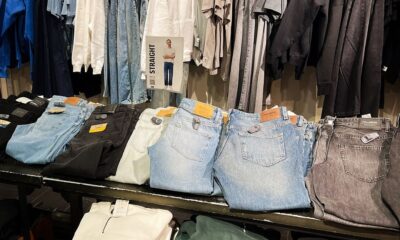Fashion
Longines expands in New York City with Soho store opening

Published
November 3, 2025
Longines announced on Friday the opening of its first Soho store, as the Swiss watchmaker expands its retail store footprint in New York City.
Located at 128 Spring Street, the new Longines Soho store spans 1,064 square feet and boasts a contemporary yet elegant design that blends the NYC area’s architecture with the winged hourglass watch brand’s heritage.
For a Big Apple touch, the store incorporates local-inspired materials such as brick walls, reclaimed wood flooring, and cast iron pre-existing elements and design pieces. As for Longines, visitors will also find references to the 193-year old brand’s history, including its love for equestrian sports and its aviation pioneering, as well as its contribution to timekeeping Alpine ski racing.
The new Soho store marks the brand’s third retail store in the U.S. and its second in New York City.
“The opening of our SoHo boutique represents more than an expansion for Longines: it’s a celebration of our deep connection to the United States, a country that has been part of our story since 1845,” said Yannick Jenni, Longines vice president of sales international, who attended the official ribbon cutting of the new store, alongside Brittany Garcia, brand president, U.S. and Caribbean, and celebrity brand ambassador, Jennifer Lawrence.
“This space reflects our timeless dedication to elegance and offers an inspiring setting for clients to discover our watches and experience the world of Longines.”
Last year, Longines opened its second store in London, opting for Covent Garden to expand its presence in the British capital.
Copyright © 2025 FashionNetwork.com All rights reserved.
Fashion
ECB keeps interest rates unchanged, upgrades growth outlook

According to updated Eurosystem staff projections, headline inflation is expected to average 2.1 per cent in 2025, easing to 1.9 per cent in 2026 and 1.8 per cent in 2027, before returning to 2.0 per cent in 2028. Inflation excluding energy and food is forecast at 2.4 per cent in 2025, gradually declining to 2.0 per cent by 2028. Inflation for 2026 has been revised upward, mainly due to expectations that services inflation will fall more slowly than previously anticipated, the Governing Council of the ECB said in a press release.
European Central Bank has kept its key interest rates unchanged, maintaining confidence that inflation will stabilise at the 2 per cent target.
Updated projections show inflation easing gradually over the coming years, with a slight upward revision for 2026 due to persistent services prices.
Economic growth forecasts have been revised higher, supported by stronger domestic demand.
The ECB also revised its economic growth outlook higher compared with its September projections. Growth is now expected to reach 1.4 per cent in 2025, 1.2 per cent in 2026 and 1.4 per cent in 2027, with expansion projected to remain at 1.4 per cent in 2028. The improvement is driven largely by stronger domestic demand across the euro area.
The Council reiterated its commitment to ensuring that inflation stabilises sustainably at the 2 per cent target. It emphasised that future monetary policy decisions will remain data-dependent and assessed on a meeting-by-meeting basis, without pre-committing to any specific interest rate path.
Fibre2Fashion News Desk (KD)
Fashion
US brand Vera Bradley posts net revenue of $62.3 million in Q3

Vera Bradley reported Q3 net revenues of $62.3 million, down from $70.5 million year over year.
Direct revenues fell 5.3 per cent, with comparable sales down 5.8 per cent, while indirect revenues dropped 30.2 per cent.
Gross margin declined to 42.1 per cent, impacted by inventory write-downs and higher duties, despite early progress from its Project Sunshine transformation.
Source link
Fashion
Community is fashion’s new competitive currency across the value chain
-

 Business6 days ago
Business6 days agoHitting The ‘High Notes’ In Ties: Nepal Set To Lift Ban On Indian Bills Above ₹100
-

 Politics1 week ago
Politics1 week agoTrump launches gold card programme for expedited visas with a $1m price tag
-

 Business1 week ago
Business1 week agoRivian turns to AI, autonomy to woo investors as EV sales stall
-

 Fashion1 week ago
Fashion1 week agoTommy Hilfiger appoints Sergio Pérez as global menswear ambassador
-

 Sports1 week ago
Sports1 week agoPolice detain Michigan head football coach Sherrone Moore after firing, salacious details emerge: report
-

 Business1 week ago
Business1 week agoCoca-Cola taps COO Henrique Braun to replace James Quincey as CEO in 2026
-

 Sports1 week ago
Sports1 week agoU.S. House passes bill to combat stadium drones
-

 Tech1 week ago
Tech1 week agoGoogle DeepMind partners with UK government to deliver AI | Computer Weekly



















